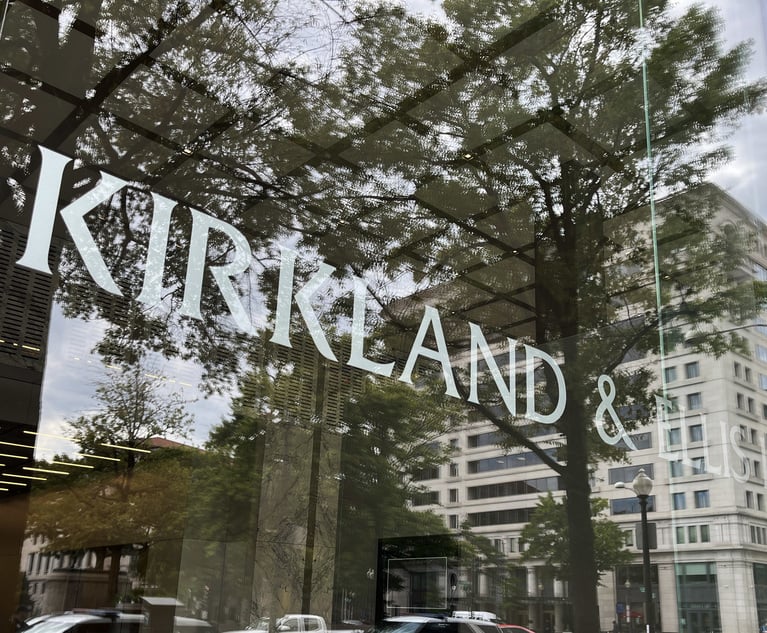How the Government Will Help Families Affected by COVID-19
Recently, the Families First Coronavirus Response Act was passed to provide financial assistance. This Act gives the response to the growing health…
May 04, 2020 at 06:42 PM
7 minute read
 Marissa Hatchett, an Associate at KoonsFuller. (Courtesy Photo)
Marissa Hatchett, an Associate at KoonsFuller. (Courtesy Photo)
Recently, the Families First Coronavirus Response Act was passed to provide financial assistance. This Act gives the response to the growing health and economic disaster with requirements for paid sick leave, free testing and expanded unemployment benefits. It also provides new federal aid to families affected by the school closings. These legislative actions would offer relief to businesses and individuals most severely impacted by COVID-19 such as various tax relief and health care benefits. During this time, business that are struggling to survive and employees who are worried about what could happen may benefit from these emergency measures.
Healthy Food for Those in Need
Prior to the pandemic, more than 37 million people in America were struggling with hunger. With companies having to cut back or fire employees, many Americans faced a growing concern of being able to provide food for their family. Passing the Families First Coronavirus Act was an important move towards providing funds to immediately help those in need.
Food for Pregnant Women, Mothers With Young Children and Low-Income Americans
The Special Supplemental Nutrition Program for Women, Infants and Children (WIC) will provide access to nutritious foods to low-income pregnant women or mothers with young children who lose their jobs or are laid off due to COVID-19. The Emergency Food Assistance Program will help local food banks meet increased demand for low-income Americans during this crisis.
Senior Citizens
The Act includes funding for the Senior Nutrition program in the Administration for Community Living to provide approximately 25 million additional home-delivered and prepackaged meals to low-income seniors who depend on the Senior Nutrition programs in their communities. This funding will provide meals to low-income seniors who are homebound, who have disabilities, who have multiple chronic illnesses, as well as caregivers for seniors who are homebound.
Aid for the Unemployed
The Families First Coronavirus Response Act provided funding for emergency grants to states for processing and paying unemployment insurance benefits. Additional funding is provided to all states for staffing, systems, technology, and other admin costs so long as they meet basic requirements about ensuring access to eligible workers who have earned the benefits. Employers will have to provide notification of potential unemployment insurance eligibility to those workers that were laid off due to COVID-19. They will have to ensure workers they have at least two ways to apply for benefits, for example either over the phone or online. These agencies will have to notify applicants when an application is received and being processed. If the application cannot be processed, they will be required to provide information to the applicant about how to ensure successful processing.
Emergency Paid Sick Days Program
Congress passed the Emergency Paid Leave Act of 2020, which requires employers with fewer than 500 employees to provide two weeks of paid sick leave. This is for employees who are unable to work because they are have a current diagnosis for COVID-19, quarantined at the instruction of a health care provider to prevent the spread of COVID-19, the employee is caring for another person who has COVID-19 or who is under a quarantine related to COVID-19, or the employee is caring for a child or other individual who is unable to care for themselves due to the COVID-19 related closing of their school, child care facility or other care program.
An employer cannot require employees to find a replacement worker for themselves or require them to use other paid time off. Eligible workers will receive a benefit for a month or up to three months in which they must take 14 or more days of leave from their work due to COVID-19 related reasons. This is equivalent to no less than two-thirds of the person's pay and up to a cap of $4,000.
As for employers, they will receive a tax credit to offset the costs of providing paid leave. The Technical Assistance and Guidance for Short-Time Compensation Program provides technical assistance to states that want to set up work-sharing programs so that employers can reduce hours instead of laying off employees. Employees can then receive partial unemployment benefits to offset the wage loss. Those that are self-employed will receive a tax credit.
How Schools Are Providing Assistance for Children in Need
Providing Meals for Children
A provision allowed the Department of Agriculture to approve state plans to provide support for the Supplemental Nutrition Assistance Program to households with children who would normally receive free or reduced-price meals. Since schools have been closed for weeks now, this will help those children receive meals. School districts have committed to offering meal service at no cost while the districts remain closed. Children 18 years and younger qualify as well as students with disabilities regardless of their age qualify. If the student is 19 years old and turns 19 during the current school year on or after the first day of school, then that student also qualifies.
For example:
- Dallas Indpendent School District will distribute meals every Thursday between 10 a.m. and 1 p.m. The child will receive five breakfasts, lunches and suppers. Meals will be distributed curbside at the main entrance of most Dallas ISD Middle School and High School. For more information visit https://www.dallasisd.org/Page/62476
- Arlington ISD will provide a light breakfast (for the following morning), lunch and one entrée. For more information visit https://www.aisd.net/coronavirus/student-meal-plan-during-school-closure/
- Garland ISD will serve breakfast Monday through Friday from 8 to 9 a.m. and lunch Monday through Friday from noon to 1 p.m. For more information visit https://www.garlandisd.net/node/11272
Providing Devices for At-Home Learning
Most school districts are providing devices such as laptops so students can participate in at-home learning while schools remain closed. If connecting to the internet is a problem, most districts have an option for families to request internet support for students who need an internet hot spot. You can visit your school district's website for more information.
Free Coronavirus Testing
Testing will be made free to the public without having to use deductibles or copayments. Private health plans will be required to provide coverage for COVID-19 diagnostic testing. This will include the cost of a provider, urgent care center and emergency room visits for testing. Individuals also receiving Medicare, Medicaid and Children's Health Insurance Program will have coverage at no cost to the beneficiary for any COVID-19 diagnostic testing or cost associated for testing. States will also have the option to extend Medicaid eligibility to uninsured populations for the purposes of COVID-19 diagnostic testing.
Each county has provided information on where coronavirus testing sites are around the city:
- Dallas County
- Dallas County will test anyone who is exhibiting shortness of breath, cough, and must show a temperature of 99.6 or higher.
- Dallas will accept people to be tested from other counties if they meet the criteria
- https://www.dallascounty.org/covid-19/testing-locations.php
- Tarrant County
Eligibility for the Stimulus Check
The government will be sending out direct payments to help individuals by using your 2019 tax return. If you have not filed your 2019 tax return then your 2018 return will be used to calculate the amount of your payments. Payments will not be subject to tax and those that owe back taxes will still get the payout. Individuals will receive up to $1,200, and married couples will receive up to $2,400 plus $500 per child. Payments will start phasing out for individuals with adjusted gross incomes of more than $75,000 and $150,000 for couples however, individuals making more than $99,000 will not receive anything. The amount will be reduced by $5 for every additional $100 of adjusted gross income.
Marissa Hatchett is an Associate at KoonsFuller.
This content has been archived. It is available through our partners, LexisNexis® and Bloomberg Law.
To view this content, please continue to their sites.
Not a Lexis Subscriber?
Subscribe Now
Not a Bloomberg Law Subscriber?
Subscribe Now
NOT FOR REPRINT
© 2025 ALM Global, LLC, All Rights Reserved. Request academic re-use from www.copyright.com. All other uses, submit a request to [email protected]. For more information visit Asset & Logo Licensing.
You Might Like
View All
Energy Lawyers Field Client Questions as Trump Issues Executive Orders on Industry Funding, Oversight
6 minute read
Holland & Knight Hires Former Davis Wright Tremaine Managing Partner in Seattle
3 minute read
Kirkland Is Entering a New Market. Will Its Rates Get a Warm Welcome?
5 minute read
Trending Stories
- 1We the People?
- 2New York-Based Skadden Team Joins White & Case Group in Mexico City for Citigroup Demerger
- 3No Two Wildfires Alike: Lawyers Take Different Legal Strategies in California
- 4Poop-Themed Dog Toy OK as Parody, but Still Tarnished Jack Daniel’s Brand, Court Says
- 5Meet the New President of NY's Association of Trial Court Jurists
Who Got The Work
J. Brugh Lower of Gibbons has entered an appearance for industrial equipment supplier Devco Corporation in a pending trademark infringement lawsuit. The suit, accusing the defendant of selling knock-off Graco products, was filed Dec. 18 in New Jersey District Court by Rivkin Radler on behalf of Graco Inc. and Graco Minnesota. The case, assigned to U.S. District Judge Zahid N. Quraishi, is 3:24-cv-11294, Graco Inc. et al v. Devco Corporation.
Who Got The Work
Rebecca Maller-Stein and Kent A. Yalowitz of Arnold & Porter Kaye Scholer have entered their appearances for Hanaco Venture Capital and its executives, Lior Prosor and David Frankel, in a pending securities lawsuit. The action, filed on Dec. 24 in New York Southern District Court by Zell, Aron & Co. on behalf of Goldeneye Advisors, accuses the defendants of negligently and fraudulently managing the plaintiff's $1 million investment. The case, assigned to U.S. District Judge Vernon S. Broderick, is 1:24-cv-09918, Goldeneye Advisors, LLC v. Hanaco Venture Capital, Ltd. et al.
Who Got The Work
Attorneys from A&O Shearman has stepped in as defense counsel for Toronto-Dominion Bank and other defendants in a pending securities class action. The suit, filed Dec. 11 in New York Southern District Court by Bleichmar Fonti & Auld, accuses the defendants of concealing the bank's 'pervasive' deficiencies in regards to its compliance with the Bank Secrecy Act and the quality of its anti-money laundering controls. The case, assigned to U.S. District Judge Arun Subramanian, is 1:24-cv-09445, Gonzalez v. The Toronto-Dominion Bank et al.
Who Got The Work
Crown Castle International, a Pennsylvania company providing shared communications infrastructure, has turned to Luke D. Wolf of Gordon Rees Scully Mansukhani to fend off a pending breach-of-contract lawsuit. The court action, filed Nov. 25 in Michigan Eastern District Court by Hooper Hathaway PC on behalf of The Town Residences LLC, accuses Crown Castle of failing to transfer approximately $30,000 in utility payments from T-Mobile in breach of a roof-top lease and assignment agreement. The case, assigned to U.S. District Judge Susan K. Declercq, is 2:24-cv-13131, The Town Residences LLC v. T-Mobile US, Inc. et al.
Who Got The Work
Wilfred P. Coronato and Daniel M. Schwartz of McCarter & English have stepped in as defense counsel to Electrolux Home Products Inc. in a pending product liability lawsuit. The court action, filed Nov. 26 in New York Eastern District Court by Poulos Lopiccolo PC and Nagel Rice LLP on behalf of David Stern, alleges that the defendant's refrigerators’ drawers and shelving repeatedly break and fall apart within months after purchase. The case, assigned to U.S. District Judge Joan M. Azrack, is 2:24-cv-08204, Stern v. Electrolux Home Products, Inc.
Featured Firms
Law Offices of Gary Martin Hays & Associates, P.C.
(470) 294-1674
Law Offices of Mark E. Salomone
(857) 444-6468
Smith & Hassler
(713) 739-1250






